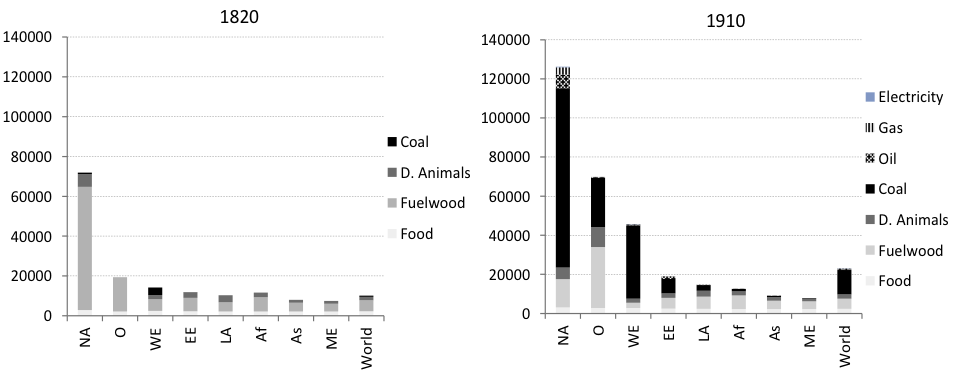A World Energy Revolution: the first phase 1820-1913
By Paolo Malanima (University «Magna Graecia» in Catanzaro)
The full article from this blog post has now been published on The Economic History Review, and it is freely available on Early View until the 15th January 2020 at this link
—
In 2016 any human being consumed every day 57,000 kilocalories (kcal) on the average; but in western Europe he/she consumed more than 100,000 kcal, in USA and Canada 200,000 and in Africa 22-23,000 (Figure 1). The remarkable increase in the capacity to do work, due to the rise in the energy consumption, marked a discontinuity in the course of the World economy and was a decisive support of Modern Growth.

Source: please refer to the full article as published on the Economic History Review
We see in Fig. 2 the change, both in aggregate (A) and per capita (B) terms. In 1820-1913 total consumption increased 3.5-4 times, and per head 2-2.5 times. The growth in the availability of energy was the same of total and per capita GDP. Actually, in this first phase of growth, 1 percent more energy input resulted into 1 percent more GDP.

This increase could not have been possible without a change in the composition of the energy sources consumed (Fig. 3). When in 1800-20 the main traditional sources were still food, firewood and fodder, consumption per head on the World scale did not exceed 10,000 kcal. It became possible to overtake this amount when primarily coal and later oil, natural gas and hydroelectricity began to be exploited on a large scale.

When traditional sources dominated, inequality in energy exploitation was very modest and primarily depended on different temperatures. Western Europe, North America and Oceania already prevailed in 1820 in energy consumption, but their population was equal to 15 percent of the World population, compared to 65-70 of Asia and Middle East. The introduction of non-renewables energy sources brought about a rising inequality, which reached a peak on the eve of the First World War and only began to diminish after the Second World War (Fig. 4).

A consequence of all this change was that in countries rich of coal, as a ratio to population (Europe, North America, Oceania), since energy per worker was remarkable, productivity and real wages were significantly higher than elsewhere. An incentive existed in those macroareas to replace labour with mechanical devices. The contribution of technology was remarkable in this process. Consider, for example, the evolution of steam engine technology between the eighteenth and nineteenth centuries which indicates the impact that technical progress exercised on the ability to exploit mechanical power.
Natural capital is ordinarily excluded from models of economic growth. Actually the role of natural resources was certainly decisive at the start of Modern Growth. For some thousands of years, in the agricultural civilisations, cultures, sciences, institutions and political systems actually changed without any substantial progress in the capacity to do work. Both real wages and incomes per capita, reconstructed recently by the historians, draw straight lines until about 1820. Many concurrent factors of change contributed to what is called today Modern Growth — cultural, political, institutional — yet, without the removal of the energy constraint, steady economic growth would have been unobtainable.
To contact the author: malanima@unicz.it

